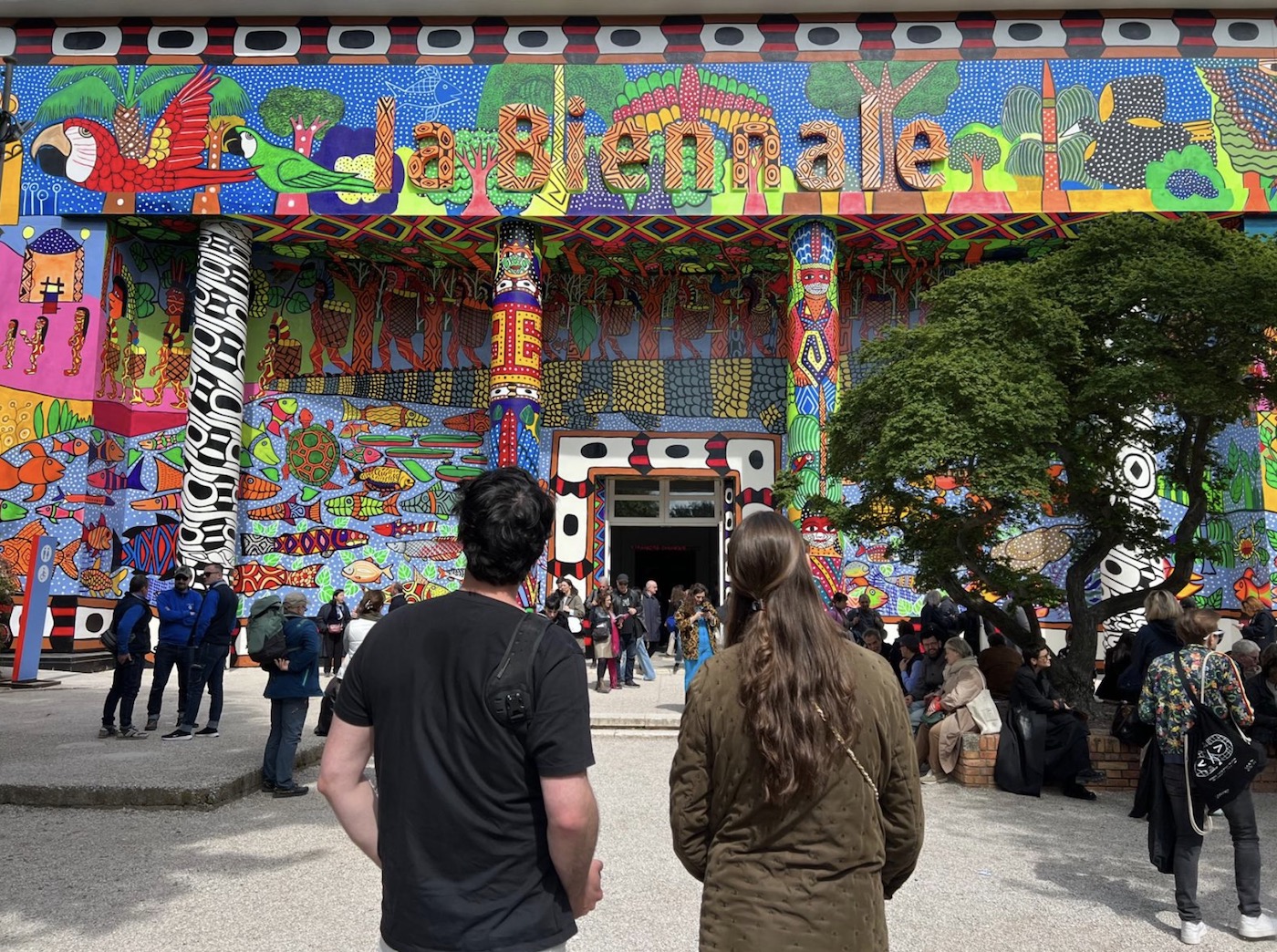Collectors and art world cognoscenti clamoured for first access to Stranieri Ovunque (Foreigners Everywhere) at the 60th edition of the Biennale di Venezia in a scene that recalls the running of the bulls in Spain or salmon spawning in Alaska.
Fortunately for those not in attendance or entirely outside of the art world, most installations and exhibitions can be seen throughout the latter half of 2024. Some seem to think that a mad dash to see things first matters, but focusing on poignant exhibitions enables the viewer to engage more meaningfully. It is impossible to see everything on display during the Biennale, but I did my best, looking at several exhibitions a day over two weeks. What matters most in an event with so much breadth is experiencing and connecting with the work, being present in the magical moments that artists create, engaging with their narratives, and seeking to understand their work better. I have avoided covering shows already written about by Artlyst colleagues as there was just so much to take in at this edition of the Venice Biennale. Foreigners Everywhere, curated by Adriano Pedrosa, has the perfect theme for the moment, given the geopolitical turmoil that is engulfing the world. This title is a message to us all to understand that, at some point or another, almost every culture on the planet was a stranger in a new land. Many indigenous artists, including Jeffrey Gibson and Archie Moore, presented site-specific installations and performances based on this theme, and many non-indigenous artists used their work to acknowledge themes like migration, access to resources, incarceration, war, and environmental shifts that create the necessity for adaptation.
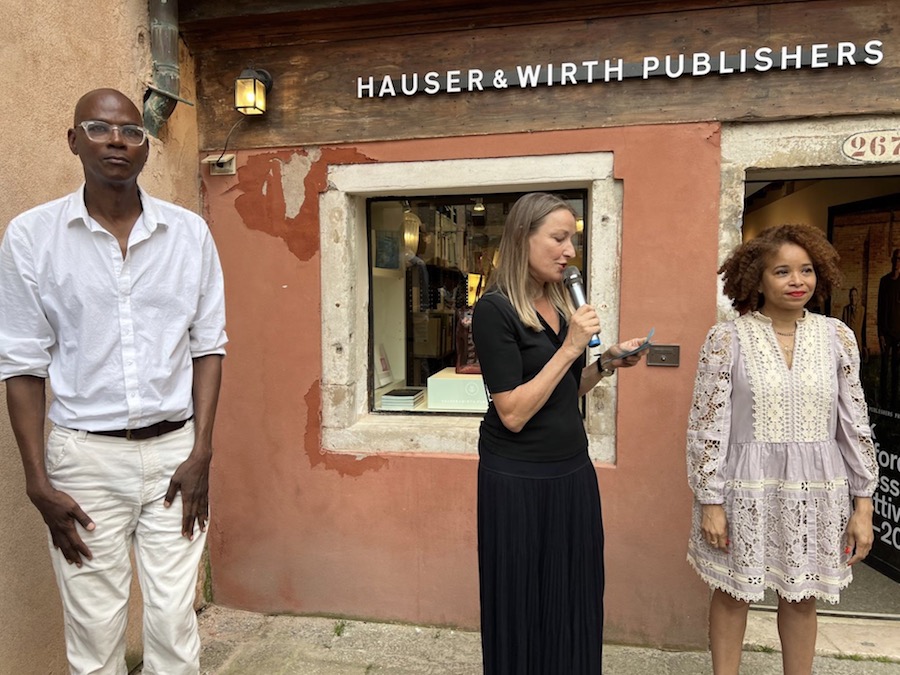
Mark Bradford, Michaela Unterdörfer, and Nicole Fleetwood at the Presentation of Mark Bradford: Process Colletivo
Mark Bradford opened the week of the Biennale with a presentation of his book Mark Bradford: Process Colletivo and an edition titled Borsa. The book shared the story of Bradford’s work with the non-profit Rio Terà dei Pensieri. This cooperative creates work opportunities that engage with present and former inmates from two prisons in Venice. The fine art edition is a beautifully coloured and etched glass tote bag, recalling the totes that the prisoners make that acclaimed Berengo studios produced. The piece also includes hash marks reminiscent of counting days in prison, which reference the counting process used at the glass maker’s studio. The double reference here is something that sets Bradford apart, as his work is so often able to speak to myriad themes. Nicole Fleetwood, editor of Bradford’s book and renowned author of Marking Time: Art in the Age of Mass Incarceration, also spoke with poignant remarks about the importance of such programs. This event was a great example of how positively art can transform the lives of those who engage with it. This project is a lasting embrace from one of the most important contemporary artists to uplift the lives of everyone, from participants to viewers.

Installation View of Monument to an Unknown Person by Ersan Mondtag at the German Pavilion
One of the most powerful presentations in the Giardini was, undoubtedly, the German Pavilion, curated by Cagla Ilk, which included works by Ersan Mondtag and Yael Bartana. Visitors queued up for over an hour to experience this surreal pavilion. The spectators arrived to find dirt blocking the front of the front entrance of the pavilion about Mondtag’s native Turkey; after all, it was sourced from there, which also served as a reference to the rebuilding of Germany’s postwar and after the collapse of the USSR. Furthermore, many foreigners must enter in ways that avoid the traditional entry points of countries, or they have to work their way into countries through special programs. Visitors then entered the pavilion and stumbled upon a dark room with booming sound and a large sculptural installation with turbines spinning behind a pod-shaped spaceship with light projecting from behind it. The light streamed through the structure as the sound echoed, creating a sense of wonder in all who entered what can only be described as something that felt like a scene from outer space. Light of the Nations is a film by Bartana on display at the pavilion and addresses the same themes of space exploration. Mondtag’s monumental installation, Monument to An Unknown Person, filled the central room with a towering structure that may be a reference to a bleak future that also references Mondtag’s grandfather, Hasan Aygun, “who came to Germany in 1968 as part of the guest worker program and died of cancer after working in an asbestos factory.” Actors go about their quotidian life without acknowledging the spectators, as an old man showers, another character sets the table, a woman uses the bathroom, and another many dresses for a day in this desiccated world. This dust-filled room and jarring experience left a strong impression on everyone who entered.

Senegal Pavilion © Courtesy of the artist and TEMPLON, Paris —Brussels — New York photographed by Laurent Edeline
The Senegal Pavilion, curated by Massamba Mbaye, at the Arsenale, was not to be missed as Alioune Diagne’s powerful presentation Bokk – Bounds, a gripping representation of life in Senegal paired with a stark contrast of the life many migrants face as they leave their homeland in search of better opportunities. The installation consisted of 18 paintings that were displayed together to complete a polyptych painting that not only showed life throughout the migration process but that only, when shown with a seamless configuration, formed the outline of a man devolving into an ape, as read from right to left. This speaks to the dehumanisation that many migrants undergo throughout their journey, as well as the inhumane conditions they may face while on this journey. The canvases are expertly rendered, recalling pointillism and calligraphy as Diagne illustrates his prowess as a painter. The works have titles like Immigrant Children, Malaanum Fippu – The Veil of Peace, Transition, Mbëggeel, and Love Bounds, which all reference different parts of the hopes and dreams many migrants have as they embark on their journeys as well as the pitfalls they may face on these perilous treks. Many migrants’ lives in their countries of origin exceed those they will find elsewhere.
In contrast, many will sadly not finish their journeys because of disease, death, and exploitation. For many migrants, their path leads backwards and to a more dire situation than before. This is the only time these works will be seen together, another reference to the diaspora that occurs during mass migration.
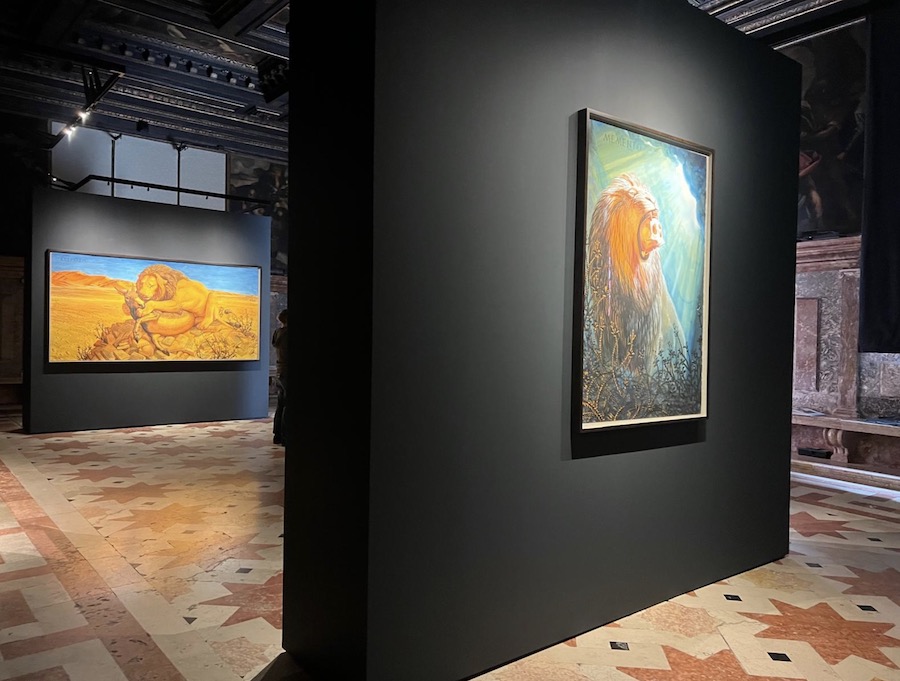
Installation view of Walton Ford Lion of God
Walton Ford had an exceptional presentation with Lion of God, curated by Udo Kittelman, that is an experience to behold at the Ateneo Veneto. The exhibition tells the story of Saint Jerome’s lion and donkey in a way that only Ford can, who forge a lifelong bond via their presence around the saint. Ford is a master of painting animals, and his watercolour techniques rival anyone who has come prior; however, some of his innovations also lie in how he imagines these creatures and often imbues an incredible sense of personality. The presentation is set between two floors, a ground floor that includes such haunting pieces as Ghost, which shows a lion prowling in the mist with a bloody bible in its mouth. Upstairs, Ford is paired perfectly with Tintoretto’s Apparizione della Vergine a San Girolamo (The Apparition of the Virgin to St. Jerome). Ford’s lion carrying books up the mountain, doing the work of the ass, is depicted laden with volumes with a desert landscape and a book that is catching fire. The lion was tricked into doing the work so traders could abscond with his friend; however, when the lion eventually realised this and saved his friend by bringing him back to St. Jerome. The traders eventually returned promising portions of their profits to the hermetic saint as compensation for their theft. Tintoretto’s painting on the wall’s reverse shows the saint with the lion in a scene where he is being enraptured by scripture. This dialogue that crosses over 400 years of art history shows exactly why old legends deserve contemporary reflections. This show is open until 22 September.

Black Portraiture: Shifting Paradigms was a two-day conference that continued a series of conferences started by Dr. Deborah Willis. Supported by Syracuse University and the Mellon Foundation, this powerful series of talks included speakers ranging from artists to anthropologists to art historians and curators. Some speakers included Titus Kaphar, Hank Willis Thomas, Carrie Mae Weems, Elvira Dyangani Ose, and Jonathan Nelson, among many other distinguished guest lecturers. The panels discussed Radical Curricula, Black Realities through Digital Media, The Politics of Return, Making Space, African Venice, and other pertinent issues. Carrie Mae Weems recounted an experience with a large tech company and realised how out of touch they were at the outset of a collaborative project together. She also showed a film that recalled the harrowing story of her grandfather, Frank Weems’ forced migration. Hank Willis Thomas discussed the disparity in the difference of experience between a physical and digital interpretation of his work The Embrace, based on the hug between Dr. Martin Luther King and his wife, Coretta Scott King, upon receiving the Nobel Peace Prize. This work highlights the importance of understanding how vital their love was for the Civil Rights movement. Kaphar spoke about his experience as a student and the lack of focus on themes that looked at the history of black people in Western Art. His work has been a successful effort at retelling the stories of those marginalised figures. He also discussed a professor discussing the “benevolent enslaver” Thomas Jefferson. This moniker makes no sense and even informed a work of his titled Beyond the Myth of Benevolence. Kaphar further spoke about his residency program, Next Haven, which creates spaces and opportunities for artists and the local community in New Haven, CT. All of these speakers seemed to address just how important perception is and how vital it is to do the work that tells a true story of the history of black people. This is a history that spans continents; it is the story of humanity itself, and yet it is also a story that has been altered and diminished throughout the history of the Western World. These examples of speakers cited here also speak to varying acts of resistance, such as the retelling of history, the use of love as a vehicle for social change, and the ongoing struggle to right the wrongs of the past through acknowledgement and a continued effort to uncover the truths or the past while also working toward a future that does not diminish the contributions of black people.

Ernest Pignon Ernest: solo show Je Est Un Autre at Fondation Louis Vuitton Espace Louis Vuitton Venezia is an excellent example of an exhibition illustrating how much work often goes into public art. Many preparatory sketches are displayed alongside large-scale reproductions of some of Pignon’s powerful murals. The work has an incredible sense of humanity, and the studies show just how well thought out they are. Pignon has brought his work to the masses since the 1960s in places you might not expect, in addition to addressing themes like political martyrdom and population displacement. His placement selection often has vast implications, and his interventions have undoubtedly inspired countless artists, from Banksy to JR. Pignon also founded a residency at his studio that hosts artists worldwide. His commitment to social practice is something to be admired and imitated for years. This exhibition is open until 24 November.

Installation view of Fabio Viale at Golden Goose Haus of Dreamers
Golden Goose Haus opened its archive to visitors for the first time on 19 April, with an event titled Haus of Dreamers celebrating its commitment to arts and culture and its long-standing reputation as one of the best shoemakers in the world. Attendees were greeted with a trompe l’oeil marble sculpture by Fabio Viale that resembled the piers in Venice that anchor gondolas and small boats, without which the city could not function. Viale is a master of marble, and this piece was lit aflame in a scene of showmanship that recalls Bernini’s pyrotechnic shows for the Barberini family. Guests were treated to a factory tour and an intimate musical performance by NYC native singer Mia Leilani. Maïa Régis, whose studio is in Palermo, was also working on large-scale paintings at the residency offered by Golden Goose, which guests were welcomed to observe. I was fortunate enough to sit across from her at dinner, and I am very excited to see her artwork evolve as she continues what is undoubtedly a career to watch. Silvio Campana’s beautiful speech encouraged guests to go out into the world in the spirit of love and creativity and to share their dreams with others to spread positivity through individuality. Golden Goose opened its doors the following evening to over 1000 guests for an event and had an open house throughout the weekend that was open and free to the general public.
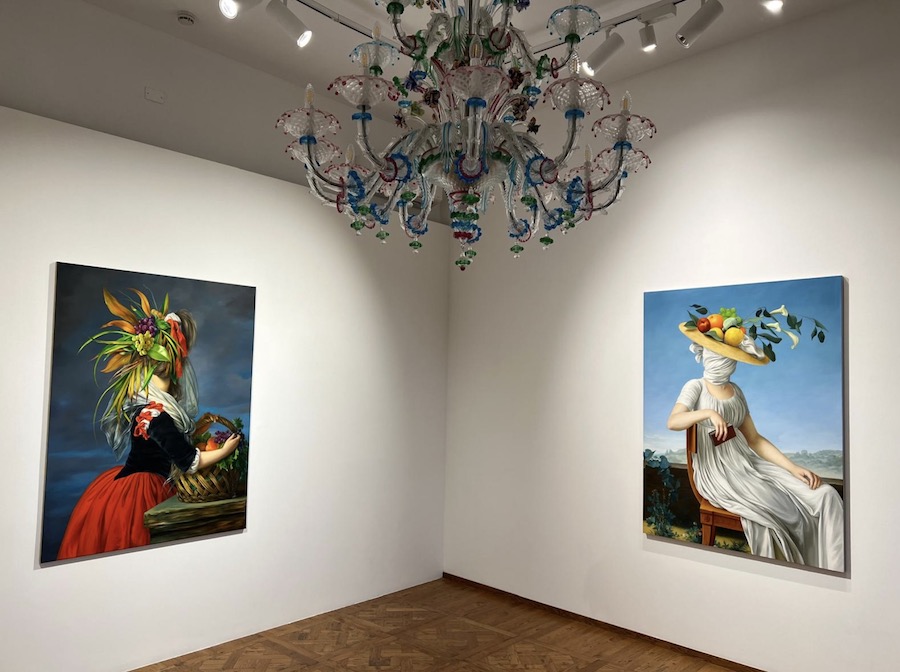
Installation view of Ewa Juskiewicz: Locks With Leaves and Swelling Buds
Ewa Juszkiewicz: Locks With Leaves And Swelling Buds, curated by Guillermo Solana at Fundación Almine y Bernard Ruiz-Picasso Palazzo Cavanis, is open until 1 September. This exhibition is beautifully arranged in a series of rooms full of intricate Venetian glass chandeliers in perfect dialogue with Juskiewicz’s work. The figures of women in 17th and 18th-century outfits with flowers, fabric, hair and cornucopias for heads speak to abundance, but there is also a reference to the expectation of female beauty throughout the history of the Western World. These sitters do not have identities, but their attributes are explicit, and this reference also speaks to the diminished focus often placed on women of those times.
Peter Hujar had an intimate presentation of the images from his first and only book publication, Portraits in Life and Death, open through 24 November. These images included figures ranging from Robert Wilson, Paul Thek, Fran Leibovitz, and Susan Sontag, among others, as well as powerful images of decomposing dressed corpses taken in the Palermo catacombs. This show evokes the memento mori present throughout Italian churches as well as the bitter fact that we will all die. It is a solemn reflection on life itself, and while the material may not be new, the sentiment is just as jarring as when the book was published. Hujar died in 1987 of AIDS, and his work remains a lasting testament to the lives of artists and creatives in NYC, as well as a stark reminder that life is fleeting.

Installation View of Christophe Büchel Monte di Pietá at Fondazione Prade Palazzo Ca’ Corner della Regina
Christoph Büchel has created perhaps the best pawn shop in the world with his piece Monte di Pietà at the Prada Foundation at Palazzo Ca’ Corner della Regina. The exhibition spans several floors and also includes a makeshift casino, a barrack room complete with video games, a dirty kitchen, a bomb shelter, a devotional chapel full of prosthetics and devices used to aid infirmed people, as well as a room that has everything from Titian to Manzoni to guns. This highly complex installation feels like a fever dream, and one cannot help but leave it feeling disoriented. This entire experience may be an indictment of modern society; however, it is also an invitation to peruse through rooms full of junk while delving for ideological and physical treasures. The show is open through 24 November.
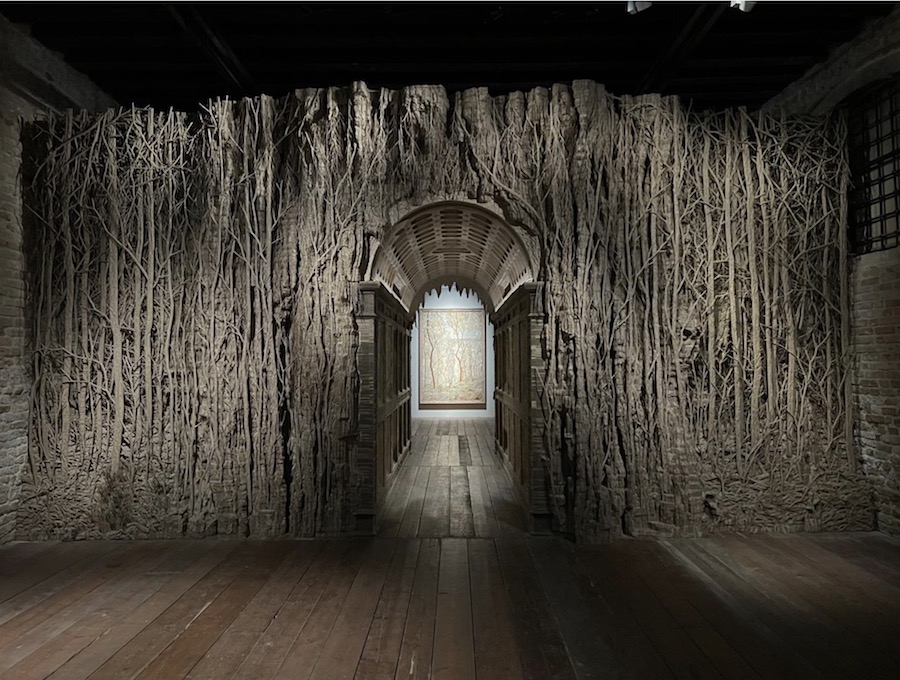
Installation view of Eva Jospin Selva at Palazzo Fortuny
Eva Jospin’s show Selva at Palazzo Fortuny was an exceptional presentation of environments and objects set in the stunning medieval palazzo. The palazzo is full of original art, copies of masterpieces, photographic prints, photo equipment, and architectural models, most of which were done by Mariano Fortuny. Jospin’s work is situated ideally in this setting as she creates immersive installations and pieces referencing elements of nature and art. Both Fortuny and Jospin are innovators in their material use and transforming seemingly banal items into vast areas for exploration. Jospin’s work interacts beautifully with the collection of the palazzo, and the show is open until 24 November.
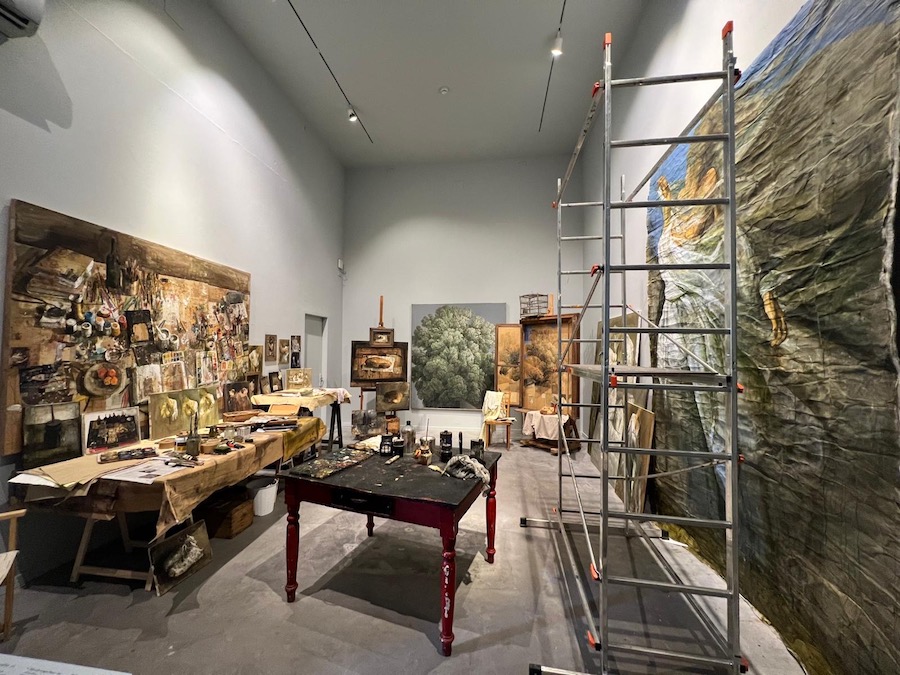
Installation view of Safet Zec at the Venice Pavilion
Bosnian octogenarian painter Safet Zec’s work at the Venice Pavilion, curated by Giovanna Zabotti, was a highlight at the Giardini. Zec carefully crafts figures on canvas or newspaper surfaces that he has meticulously pieced together. There is even a replica of his studio in a gesture that invites the viewer in on the creative process. These works show a real sense of self, depicting love, anguish, and other emotions characterising the human experience. Zec’s underlying virtuoso talent helps to heighten the appeal of the paintings. There is a replica of the artist’s studio that also speaks to the individualistic nature of artistic production and the idea that even though artists may use many of the same techniques, they all have unique environments that ensure that their output is both individual and varied.
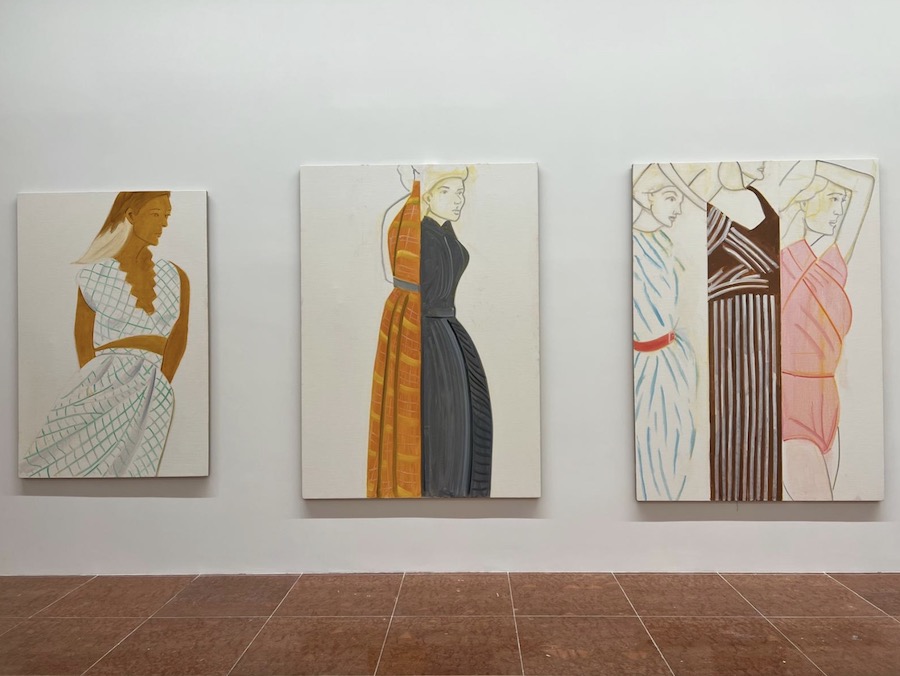
Alex Katz Claire, Grass and Water, curated by Luca Massimo Barbero and supported by Thaddaeus Ropac Gallery, is a stunning presentation of works created between 2021 and 22. Katz is in excellent form as nonagenarians produce large-scale landscapes and portraits that would exhaust young painters. On the heels of a 2022 retrospective at the Guggenheim, Katz is an anomaly of singular production and is one of the last standing artists of the revered Pop Art movement of the mid-20th century. The black and white landscapes invoke Zen painting tradition and Rothko’s final period exploring black and white imagery while the depictions of fashion designer Claire McCardell are colorful and whimsical. McCardell died in 1958 at 52; however, her influence inspires designers today. Katz continues to innovate despite his age and is an excellent example of why we should all hope for artists to live as long as possible. The exhibition at Fondazio Giorgio Cini is open through 29 September.

Installation of Jim Dine Dog on the Forge
Jim Dine is another artist whose origins trace back to Pop Art and who is in great form with a presentation at Palazzo Rocca Contarini Corfù, open through 21 July and presented by TEMPLON. Dog on the Forge, curated by Gerhard Steidl, is a comprehensive presentation of 32 works made for this show. Sculptures are placed beautifully in the palazzo’s garden and throughout the building. There are Venuses, heart paintings, a monumental hammer, a room of Pinocchios, and two giant vases with writing scrawled around them. The paintings are also assemblages that include materials like saws, chains, and copper coils that rhythmically play with the surface of the paintings. Dine has such a distinct visual language; ironically, this show does not show his dogs despite the exhibition title; perhaps this is the point. His production is also full of symbols and references to the palazzo, with the painting even fitting perfectly within the sculptural niches of the palazzo.
No exhibition illustrated active resistance through art more than Daring to Dream in a World of Constant Fear, presented at Victor Pinchuk Foundation Palazzo Contarini Polignac until 1 August. “The exhibition weaves a tapestry of stories and dreams gathered from all over, including 22 artists and collectives: Kateryna Aliinyk, Allora & Calzadilla, Alex Baczyński-Jenkins, Fatma Bucak, David Claerbout, Shilpa Gupta, Oleg Holosiy, Nikita Kadan, Zhanna Kadyrova, Dana Kavelina, Nikolay Karabinovych, Lesia Khomenko, Yana Kononova, Kateryna Lysovenko, Otobong Nkanga, Wilfredo Prieto, Oleksiy Sai, Anton Saenko, Fedir Tetianych, Anna Zvyagintseva, Roman Khimei and Yarema Malashchuk, Daniil Revkovskiy and Andriy Rachinskiy.” The show is curated by Bjorn Geldhof, Ksenia Malykh, and Oleksandra Pogrebnyak, with the help of assistant curator Oksana Chornobrova. Artist Zhanna Khadyrova uses Russian missiles in her piece, Russian Contemporary Baroque, to create a functioning organ that is a snub to the attempted destruction of her home country. Music can be made with missiles intended to destroy and obliterate moments of joy. Works referencing forced displacement, human rights abuses, the attempted destruction of heritage, and the cultural losses inflicted by conflict. This entire presentation is jarring and uplifting, given it is a testament to enduring acts of resistance while facing overwhelming odds and the spectre of continued conflict. This show runs through 1 August.

Still from Repeat After Me II by Malgorzata Morgan-Tas at the Polish Pavilion
Małgorzata Mirga-Ta’s work Repeat After Me II, presented at the Polish Pavilion and curated by Wojciech Szymański. Joanna Warsza is a stark reminder of the psychological scars of war on those around it. Refugees from the conflict in Ukraine make the sounds of armaments, ranging from missiles to mortars to guns, in videos where they then invite the audience to repeat the sounds after them. The sounds are phonetically spelt, and microphones are placed in the space for the audience to use to make the sounds themselves. In my experience and that of others I spoke with, nobody in the audience chose to repeat the sounds. This is a compelling statement that even though we may be aware of conflicts and all sympathise with those experiencing these conflicts; we often do not participate in the simplest acts of acknowledgement. It is far easier for us to spectate the horrors of war as they unfold.
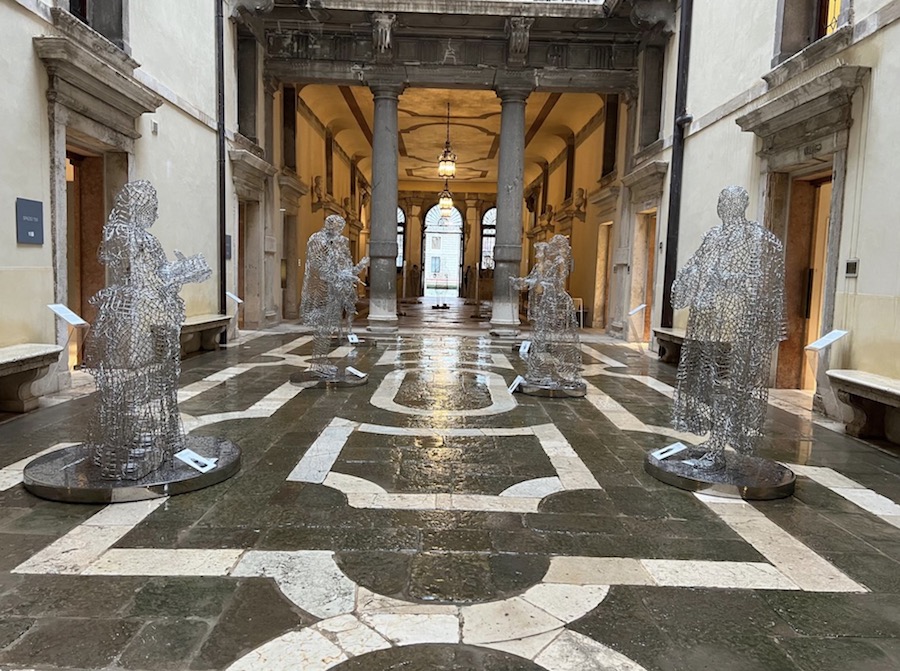
Installation View Lorenzo Quinn Anime di Venezia, Souls of Venice
Lorenzo Quinn’s Anime di Venezia, Souls of Venice, curated by Chiara Squarcina at Ca Rezzonico, is a small but powerful show. Figures varying from Marco Polo to Rosalba Carriera are depicted via metal structures resembling the outlines of the historic people. They are doing their daily business in the expansive courtyard of this exceptional palazzo. One can imagine their presence as the sculptures are accurately scaled to the figures. There is also an interactive component of the exhibition that provides even more depth to the work. This museum is also home to an incredible archive of Venetian life, and the collection includes many Ming dynasty vases, Edo vases, maps, paintings, and tapestries. This exhibition is up through 15 September.

Zeng Fanzhi: Near and Far/Now and Then in Venice at Scuola Grande della Misericordia, co-curated by Michael Govan and Stephen Little, is a tour de force. Coupled with architectural interventions by Tadao Ando, the exhibition is a riveting experience from start to finish. The ground floor has two monumental compositions spaced at a distance that spans the vast room, with a floor covered in steel plates. The upstairs has a series of temporary walls with windows that get incrementally larger from wall to wall and,mpses of works and alter, the perception of the scale of works as seen from different vantage points. There is also a drawing room with works that recall vaunted traditional Chinese landscape paintings and have delicate depictions of everything from Adam and Eve to a crucifixion scene. The organisation, established with the support of LACMA, is open through 30 September.

Installation View of Planéte Lalanne
Ben Brown Fine Art presented a comprehensive exhibition of Planéte Lalanne, curated by Jerome Neutres, featuring over 250 works by Claude and François-Xavier Lalanne at Palazzo Rota Ivancich. This is the largest exhibition of the artist duo to date and includes everything from preparatory sketches, videos, prototypes, and finished pieces. The whimsical world of Les Lalannes, as they were often known, is extensive and spans two floors and several rooms, giving the impression of an environment lived in. Many works are sourced from private collections, while some are for sale, in a brilliant effort to assemble as much as possible and to show the scope of the duo’s breadth of artistic production and the singularity of their vision. Nature was a font of inspiration for the two, and while they were undoubtedly innovative, there are nods to Art Nouveau and the Belle Époque. The experience is like being in a fantastic dream full of creations that blow the viewer’s mind and invite new discourse around the work of two titans of the 20th century.
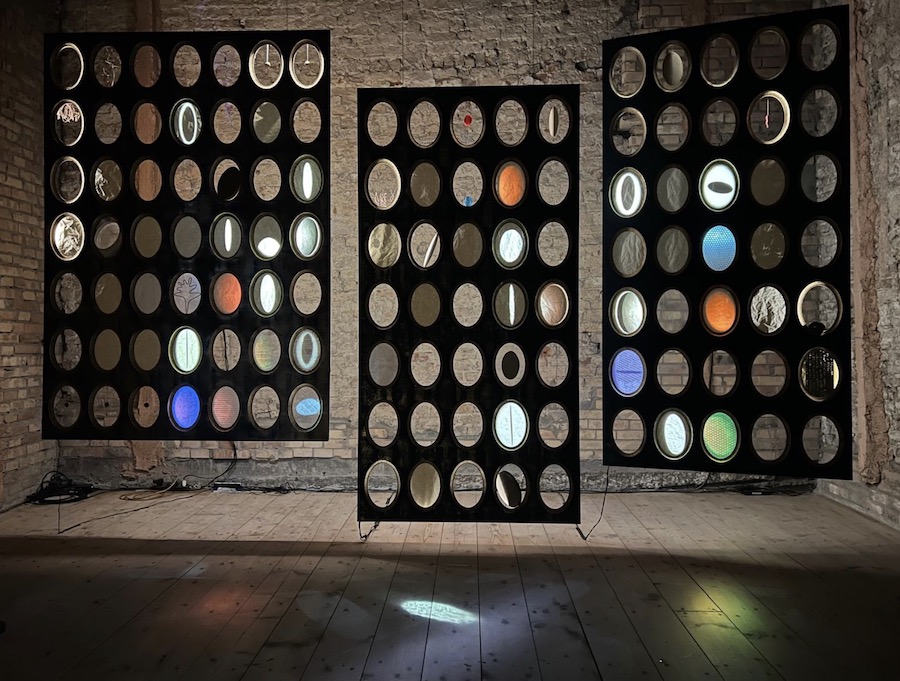
Installation View of marionanni Ilrespirodellaluce Breath of Light
The marionanni exhibition ilrespirodellaluce Breath of Light opened with a private dinner at Palazzo Marcello. He is a master of light, and several sculptures enhance rooms around them while others are even presented in dialogue with the Grand Canal. There is a room with colourful lights set in sculptures that make ellipses that are either void of anything or filled with colourful elements and have varying designs. The gathering brought together artists from around the world and Italian visionaries in a setting that celebrated the artist’s long career. The show left the viewer feeling the impact of the light interventions and environments and a deep respect for how drastically this type of work can change an environment. Geometry is also a focus of his work, and many beautiful angles bisected walls and cut space in a way mimetic of a razor’s edge. The exhibition will run through 30 June.
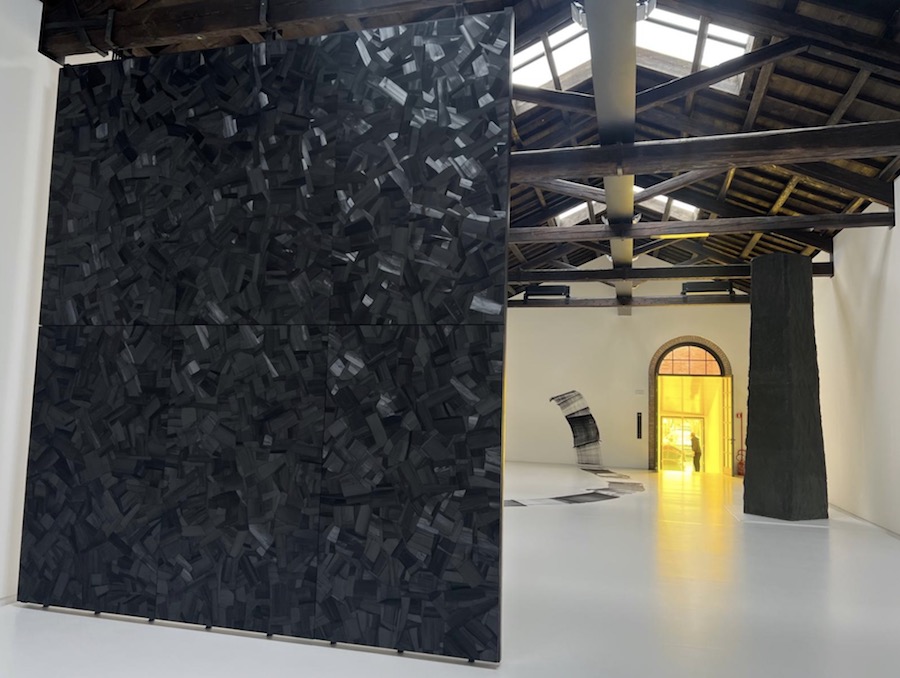
Installation view of Lee Bae La Maison de La Lune Brûlée
Lee Bae had a powerful solo presentation at the Wilmotte Foundation titled La Maison de la Lune Brûlée, curated by Valentina Buzzi. This show seemed to acknowledge the space in a way that many other exhibitions did not. Upon entering the space, a video spanned a long, dark corridor featuring snippets of the process and the philosophy behind the work. A monolith of stone with a striated pattern etched across its dark, rough surface, sourced from Zimbabwe, towered over the central room. A beautifully crafted panel wall of burnt wood is pieced together seamlessly to form a large-scale, shiny graphite surface. Calligraphic brush strokes cascade down a wall and across a large swath of the floor; the paint is a mixture of oil and ash, eventually rising back up the wall across the room. There is also a yellow room that references the moon, which makes the entire room read as a purplish hue upon teen try. This exhibition is a feast for the senses and a solid reminder of the versatility of Bae’s practice.

Installation View of Shahzia Sikander Collective Behavior
Shahzia Sikander’s Collective Behavior, curated by Ainsley M. Cameron and Emily Liebert, shows how diverse her body of work is with this landmark exhibition at Palazzo Van Axel. A golden sculpture sits alone in a courtyard next to an old Venetian cistern, and a long staircase leads the viewer up to the central part of the show. Here, we find video art, works on paper, stained glass, sculptures, and works on canvas. Some works recall paintings from the Mughal dynasty, while others refer to illuminated manuscripts. Sikander plays with perception a lot, and source material is another way for her to do so. Her output is masterful regardless of the medium used to produce her work. This exhibition, supported by the Cincinnati Art Museum and the Cleveland Museum of Art, includes works that span back to 1989 and is up until 20 October.

Jean Cocteau: The Juggler’s Revenge at Peggy Guggenheim Collection is the most extensive retrospective ever for the French artist and is organised by Kenneth Silver. The show is vast in scope and shows many periods of the artist’s life, dating from surrealism (before his expulsion at the behest of André Breton because he was a homosexual) and ending in his later years when he had achieved iconic status as a filmmaker and artist. We see many inner musings by Cocteau, and his sense of humour comes into play throughout the comprehensive show. There is even the mention of the troubling friendship Cocteau had with Nazi sympathiser sculptor Arnold Breker. Cocteau seems to have been a man of many contradictions and changed throughout his life. His exceptional talent as a draftsman, coupled with his willingness to experiment in almost every media, makes his artistic legacy extremely complex and spans his entire life. His use of opium and other substances further muddies any attempt to understand both the man and the artist fully. The exhibition closes with the display of Cocteau’s sword, made by Cartier, which was created in recognition of his being awarded Chevalier de la Ordre National de la Légion d’Honneur. The exhibition is up through 16 September 2024.

Installation View of Francesco Vezzoli: Musei delle Lacrime
Francesco Vezzoli: ‘Musei delle Lacrime’ is an excellent dialogue between the renowned collection of Museo Correr and the artist’s extensive body of work. The artist has reproduced many famous Western art pieces but has altered them all in his own way. He has intervened by sewing tears onto some images, having a linen cloth emerge from the eye of a wood sculpture, and embellishing others even more. Vezzoli includes celebrity portraits, ranging from Naomi Campbell as Madonna and Child to Richard Gere as Botticelli’s Venus. A central room has a large pink architectural environment that the viewer enters without leaving the previous space entirely. It also serves as a low-height wall with items such as a portrait of Louise Bourgeois with black triangle-like tears streaming from her face. This show is on through 24 November.
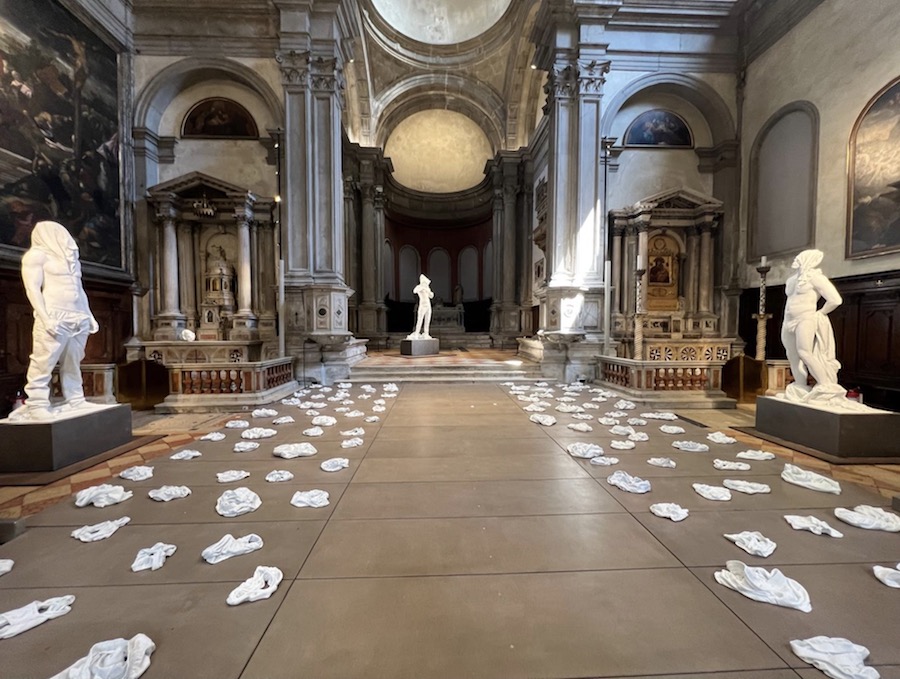
Installation view of Reza Aramesh Number 207
Number 207 is an incredibly moving presentation by Reza Aramesh at Chiesa di San Fantin, curated by Serubiri Moses, and presented by MUNTREF, Buenos Aires, with support from the Institute of Contemporary Art, ICA, Miami. A beautiful large hall contains 207 hand-carved Carrara marble sculptures of men’s undergarments and several standing figures. What at first reads as idealised beauty yields the horrible realisation that these sculptures all reference acts of torture or degradation carried out in prisons around the world. A large marble sculpture resembling one of Michelangelo’s slaves from the Louvre undresses while a few others stand in varying degrees of disrobing. A couple of marble heads are placed on altars, reminiscent of ancient sacrifices. These sculptures are all carried out in a highly meticulous fashion, and the sheer scale of the work that went into making this exhibition is impressive. The room’s mood is sombre as a voice reads out different Actions accompanied by prison names.
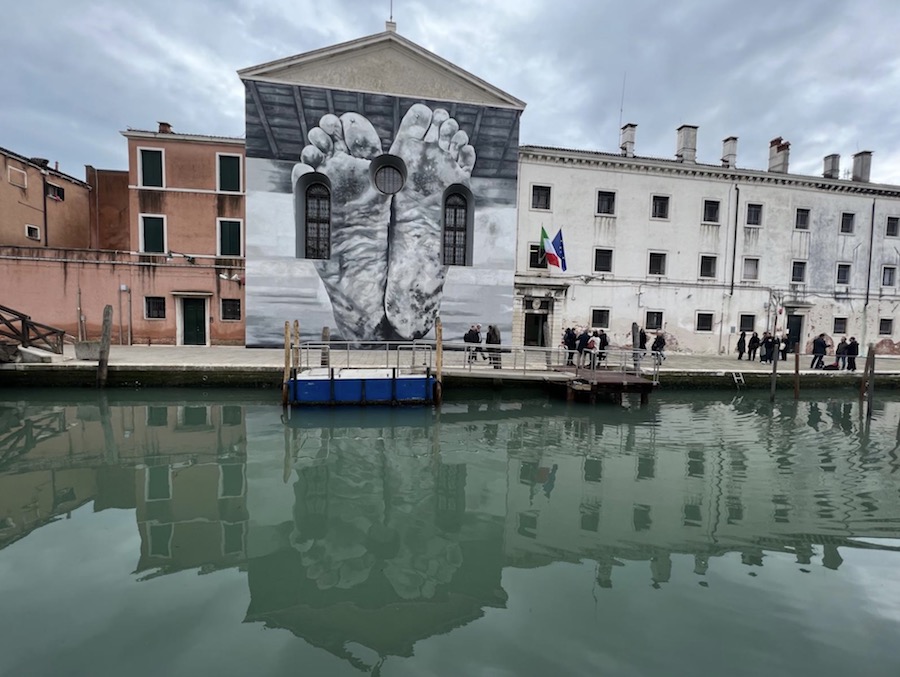
View of the Casa di Reclusione Femminile and the Pavilion of the Holy See, mural by Maurizio Cattelan
Perhaps the most powerful experience of the entire Biennale was With My Eyes, presented by the Pavilion of the Holy See, curated by Chiara Paris and Bruno Racine, at the women’s prison Casa di Reclusione Femminile, known as Convertite. Artists included Maurizio Cattelan, Bintou Dembélé, Simone Fattal, Claire Fontaine, Sonia Gomes, Corita Kent, Marco Perego & Zoe Saldana,and Claire Tabouret. No photos were allowed on the prisoner-led tours, which heightened the experience as visitors were allowed in the facility. Zoe Saldana acts in Dovecote, a gut-wrenching and moving film directed by Marco Perego that documents an inmate’s release. Claire Tabouret created images using source material from the inmates that reference their childhoods or lives before incarceration. Maurizio Cattelan depicts an image of dirty feet outside the pavilion, a reference to both Mantegna and Caravaggio. It also calls attention to the idea that great people come from all walks of life. It marks the first time the Vatican has participated in the art exposition, and the pavilion is a visceral experience that must not be missed. Art has the power to heal wounds and is curative.
Venice Biennale is on until November 2024

